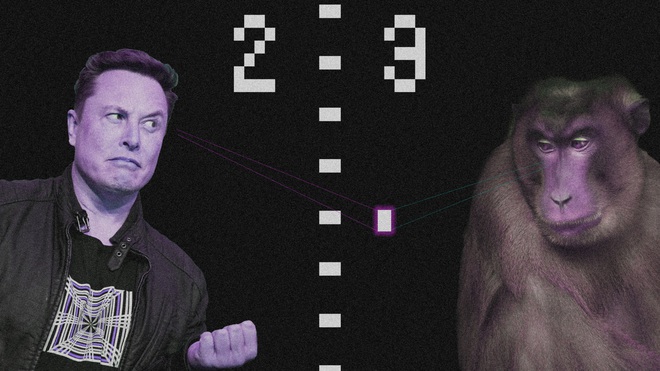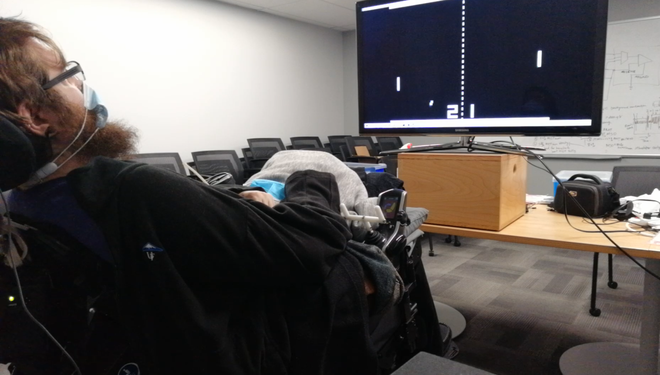Paralyzed man challenges Elon Musk’s chip-implanted monkey with ‘war of thoughts’
- Tram Ho
A man with a brain implant that allows him to control a computer via neural signals says he’s ready to challenge Elon Musk’s neuroscience company Neuralink to a game of Pong — confront a monkey .

Neuralink is developing advanced wireless brain implants so that people can connect directly to computer networks. In April, researchers working with the company showed off a video of a fawn named Pager, which can play the classic game of Pong using thought cues.
“As soon as I saw it, I wondered if I could beat that monkey,” said Nathan Copeland, who six years ago received another type of implant he normally uses to play games. play game.
Copeland was injured in a car accident and is now unable to walk or move his fingers. He still has motion in his shoulder and he can operate the computer and trackpad by typing with the flesh of his fist. That means he is not completely dependent on the brain. “However, I like to play with my brain, ” he said.
Copeland says he is now ready to challenge the monkey to the first “battle of the species” at Pong.
“We are preparing and practicing, ” said Copeland, who has been playing Pong by mind for the first time.

Nathan Copeland uses a neural implant to play Pong using his brain signals at the University of Pittsburgh.
A match of brain signals between humans and monkeys will help advance scientific understanding. What it will highlight is the potential for brain-machine technology to give severely paralyzed people more free access to computers and the internet for whatever purpose they need or want.
Pong matches can be hosted online and broadcast on Twitch, the streaming service for gamers, where Copeland has a profile and dreams of stardom with thousands of followers.
Neuralink’s original goal for its implant, as explained in a blog post last month, was to “give back to paralyzed people their digital freedom” by ways that allow them to “communicate more easily via text, satisfy their curiosity on the web, express their creativity through photography and art, and, yes, to play games.”
Copeland used brain signals to play games including Sega classics like Sonic the Hedgehog. He admits that it is a “conundrum” whether to challenge Musk’s monkey. “I can be beaten,” he said. “But yeah, I’ll play.”
Neuralink, a company founded by Musk in 2016, has not yet responded to Copeland’s challenge.
Brain interfaces work by recording electrical firing of neurons in the motor cortex, the part of the brain that controls movement. The firing rate of each neuron contains information about the movements the subject is making or merely imagining. A “decoder” program then converts the signals into an instruction that can be passed to the computer pointer.
Copeland is one of a few people with an older type of implant, known as the Utah array, used in experiments at the University of Pittsburgh to do things including move robotic arms. Before Copeland performs a task, he begins with a 10-minute training session so that an algorithm can map the firing signals from his neurons into specific movements. . After one such session, Copeland said, he might think the computer’s cursor left or right, forward or backward. Think of closing your hand to make a mouse click.

This picture of the cat was drawn by Nathan Copeland, who is paralyzed but uses a brain-computer interface to control the computer. Images sold as NFT
Starting last March, the Pittsburgh team arranged for Copeland to use his own brain implant, at home, to operate a tablet computer. He used it to surf the web and draw a picture of a cat with a painting program. Last spring, he used it six hours a day. “ It helped me through the pandemic, ” he said.
However, the tablet is not particularly powerful. “I encouraged him to be careful with the software he installed on it,” said Jeffrey Weiss, a researcher in Pittsburgh who works with Copeland . I have no other restrictions other than not breaking the thing and not getting malware on it. It’s just a Windows machine. “
Copeland’s look was installed by a neurosurgeon six years ago. He has four silicone implants. Two sections of the motor cortex allow him to control a robotic arm used in experiments or a computer pointer. The other two times, in the sonosensory part of the brain, allowed the scientists to send signals into his mind, which he recorded as a feeling of pressure or tingling in his fingers.
If a battle of wits occurs, Neuralink’s monkey will have the edge in the next-generation interface, which the company calls “the Link”. While Copeland had to attach cables to two ports on his skull, Neuralink’s implant was about the size of a soda bottle cap and fully embedded in his skull. It transmits brain recordings wirelessly, via Bluetooth.
“It’s a very promising device, but it’s new and raises a lot of questions,” says Weiss . No one but Neuralink can see it.” The company says it hopes to recruit human subjects, but that will depend on how the long-term transplant works in animals, including pigs, for which Neuralink is testing. . “Nobody knows if it will last six months or six years,” says Weiss .
The Neuralink implant also records from more neurons at once than previous devices. The monkey brain model used about 1,000 fine-wire electrodes, while electrodes in Copeland’s motor cortex recorded from about 160 motor neurons at once.
Weiss says he’s not sure who will win the Pong match, and it’s unclear whether recording from more neurons improves control over two-way movements in Pong. “The monkeys are probably not better, but what they have is a lot of practice time,” he said.
But Pong is also an ingenious mind game. As a human, Copeland will have the advantage of dexterity: Pong allows players to hit the ball at sharper angles, use risky moves such as quickly moving the support to block or attack from the corner.
Copeland started practicing this week in the Pittsburgh lab. He hopes to find a sponsor to support him and possibly raise funds for a new computer. After playing, he was reminded that Pong wasn’t easy: “I’ll definitely need to practice more,” he said.
Reference: TechnologyReview
Source : Genk
